The Structure of Business: Legal Structures and Finance
VerifiedAdded on 2022/11/23
|11
|3944
|349
Report
AI Summary
This report provides a comprehensive analysis of business structures, focusing on the legal statuses a startup can adopt, including sole proprietorship, partnership, Limited Liability Corporation, and corporations, highlighting their respective strengths and weaknesses. It then delves into various sources of finance available to startups, such as group funding, incubators, and bank loans, evaluating the advantages and disadvantages of each. Furthermore, the report identifies and differentiates between the primary, secondary, and tertiary sectors of the UK economy, explaining their individual contributions. The report also highlights the significance of Human Resource policies in modern workplaces. The report is structured to provide a clear understanding of key elements crucial for entrepreneurial ventures, offering insights into financial strategies and the broader economic landscape.
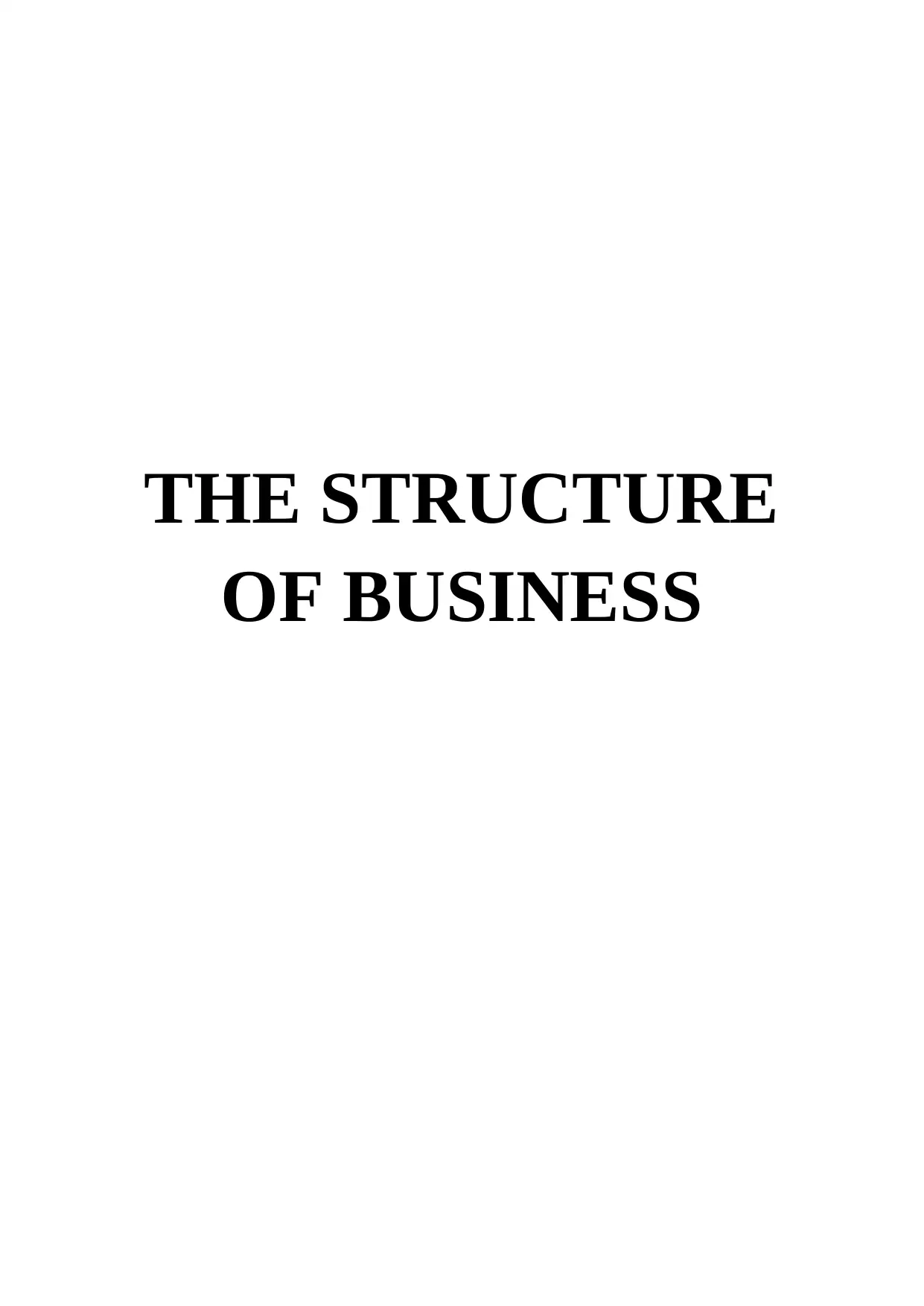
THE STRUCTURE
OF BUSINESS
OF BUSINESS
Paraphrase This Document
Need a fresh take? Get an instant paraphrase of this document with our AI Paraphraser
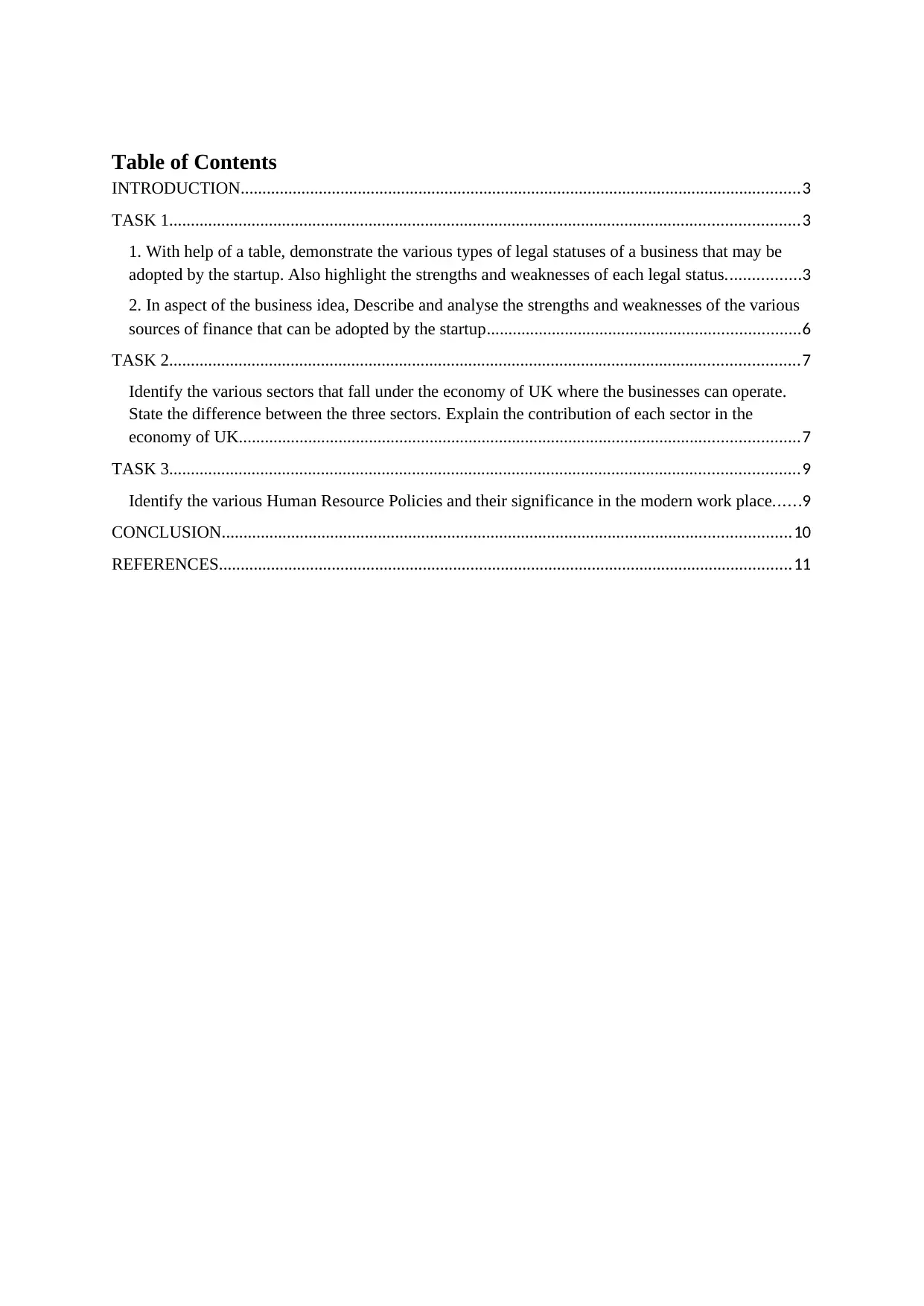
Table of Contents
INTRODUCTION.................................................................................................................................3
TASK 1.................................................................................................................................................3
1. With help of a table, demonstrate the various types of legal statuses of a business that may be
adopted by the startup. Also highlight the strengths and weaknesses of each legal status.................3
2. In aspect of the business idea, Describe and analyse the strengths and weaknesses of the various
sources of finance that can be adopted by the startup........................................................................6
TASK 2.................................................................................................................................................7
Identify the various sectors that fall under the economy of UK where the businesses can operate.
State the difference between the three sectors. Explain the contribution of each sector in the
economy of UK.................................................................................................................................7
TASK 3.................................................................................................................................................9
Identify the various Human Resource Policies and their significance in the modern work place......9
CONCLUSION...................................................................................................................................10
REFERENCES....................................................................................................................................11
INTRODUCTION.................................................................................................................................3
TASK 1.................................................................................................................................................3
1. With help of a table, demonstrate the various types of legal statuses of a business that may be
adopted by the startup. Also highlight the strengths and weaknesses of each legal status.................3
2. In aspect of the business idea, Describe and analyse the strengths and weaknesses of the various
sources of finance that can be adopted by the startup........................................................................6
TASK 2.................................................................................................................................................7
Identify the various sectors that fall under the economy of UK where the businesses can operate.
State the difference between the three sectors. Explain the contribution of each sector in the
economy of UK.................................................................................................................................7
TASK 3.................................................................................................................................................9
Identify the various Human Resource Policies and their significance in the modern work place......9
CONCLUSION...................................................................................................................................10
REFERENCES....................................................................................................................................11
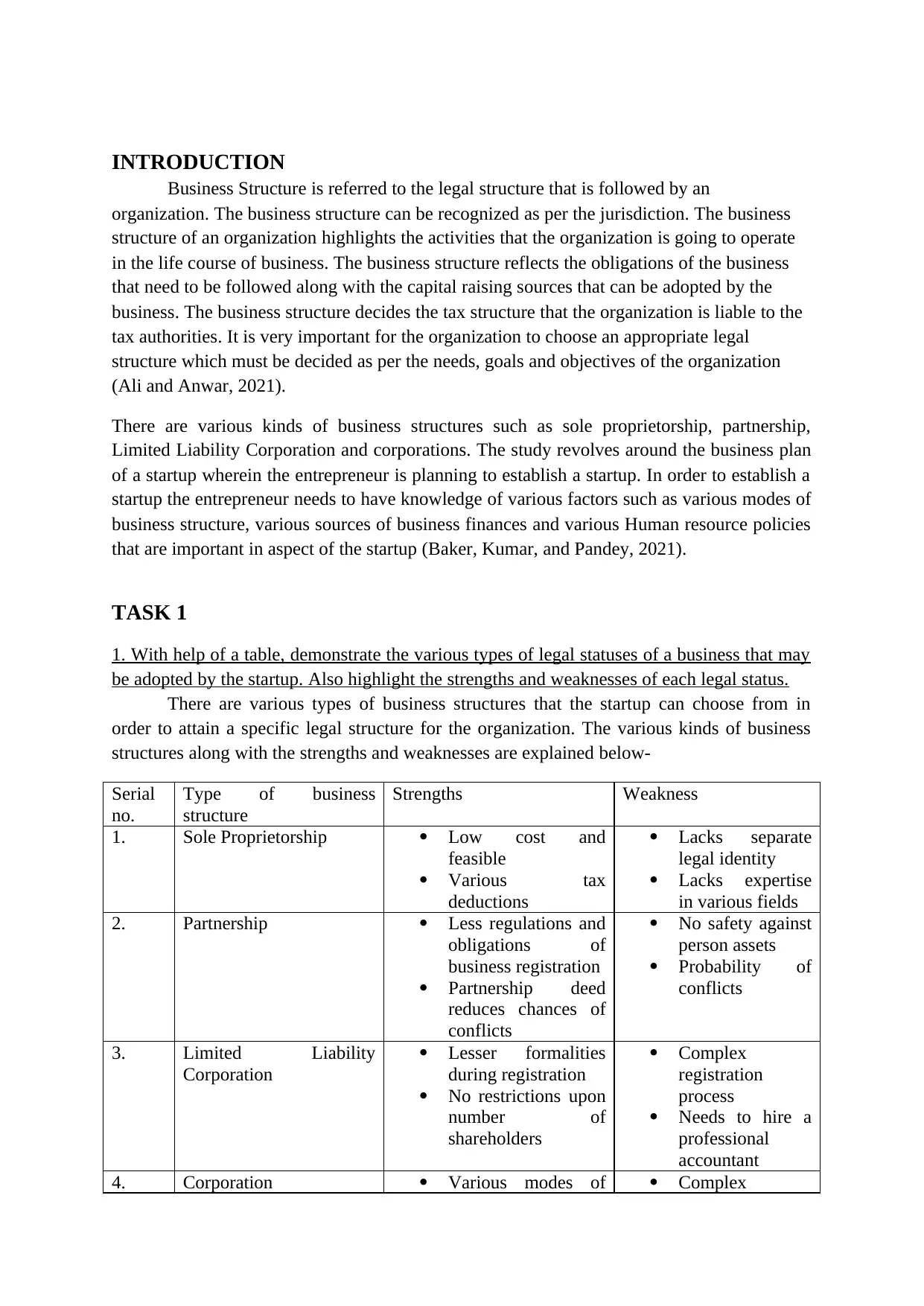
INTRODUCTION
Business Structure is referred to the legal structure that is followed by an
organization. The business structure can be recognized as per the jurisdiction. The business
structure of an organization highlights the activities that the organization is going to operate
in the life course of business. The business structure reflects the obligations of the business
that need to be followed along with the capital raising sources that can be adopted by the
business. The business structure decides the tax structure that the organization is liable to the
tax authorities. It is very important for the organization to choose an appropriate legal
structure which must be decided as per the needs, goals and objectives of the organization
(Ali and Anwar, 2021).
There are various kinds of business structures such as sole proprietorship, partnership,
Limited Liability Corporation and corporations. The study revolves around the business plan
of a startup wherein the entrepreneur is planning to establish a startup. In order to establish a
startup the entrepreneur needs to have knowledge of various factors such as various modes of
business structure, various sources of business finances and various Human resource policies
that are important in aspect of the startup (Baker, Kumar, and Pandey, 2021).
TASK 1
1. With help of a table, demonstrate the various types of legal statuses of a business that may
be adopted by the startup. Also highlight the strengths and weaknesses of each legal status.
There are various types of business structures that the startup can choose from in
order to attain a specific legal structure for the organization. The various kinds of business
structures along with the strengths and weaknesses are explained below-
Serial
no.
Type of business
structure
Strengths Weakness
1. Sole Proprietorship Low cost and
feasible
Various tax
deductions
Lacks separate
legal identity
Lacks expertise
in various fields
2. Partnership Less regulations and
obligations of
business registration
Partnership deed
reduces chances of
conflicts
No safety against
person assets
Probability of
conflicts
3. Limited Liability
Corporation
Lesser formalities
during registration
No restrictions upon
number of
shareholders
Complex
registration
process
Needs to hire a
professional
accountant
4. Corporation Various modes of Complex
Business Structure is referred to the legal structure that is followed by an
organization. The business structure can be recognized as per the jurisdiction. The business
structure of an organization highlights the activities that the organization is going to operate
in the life course of business. The business structure reflects the obligations of the business
that need to be followed along with the capital raising sources that can be adopted by the
business. The business structure decides the tax structure that the organization is liable to the
tax authorities. It is very important for the organization to choose an appropriate legal
structure which must be decided as per the needs, goals and objectives of the organization
(Ali and Anwar, 2021).
There are various kinds of business structures such as sole proprietorship, partnership,
Limited Liability Corporation and corporations. The study revolves around the business plan
of a startup wherein the entrepreneur is planning to establish a startup. In order to establish a
startup the entrepreneur needs to have knowledge of various factors such as various modes of
business structure, various sources of business finances and various Human resource policies
that are important in aspect of the startup (Baker, Kumar, and Pandey, 2021).
TASK 1
1. With help of a table, demonstrate the various types of legal statuses of a business that may
be adopted by the startup. Also highlight the strengths and weaknesses of each legal status.
There are various types of business structures that the startup can choose from in
order to attain a specific legal structure for the organization. The various kinds of business
structures along with the strengths and weaknesses are explained below-
Serial
no.
Type of business
structure
Strengths Weakness
1. Sole Proprietorship Low cost and
feasible
Various tax
deductions
Lacks separate
legal identity
Lacks expertise
in various fields
2. Partnership Less regulations and
obligations of
business registration
Partnership deed
reduces chances of
conflicts
No safety against
person assets
Probability of
conflicts
3. Limited Liability
Corporation
Lesser formalities
during registration
No restrictions upon
number of
shareholders
Complex
registration
process
Needs to hire a
professional
accountant
4. Corporation Various modes of Complex
⊘ This is a preview!⊘
Do you want full access?
Subscribe today to unlock all pages.

Trusted by 1+ million students worldwide
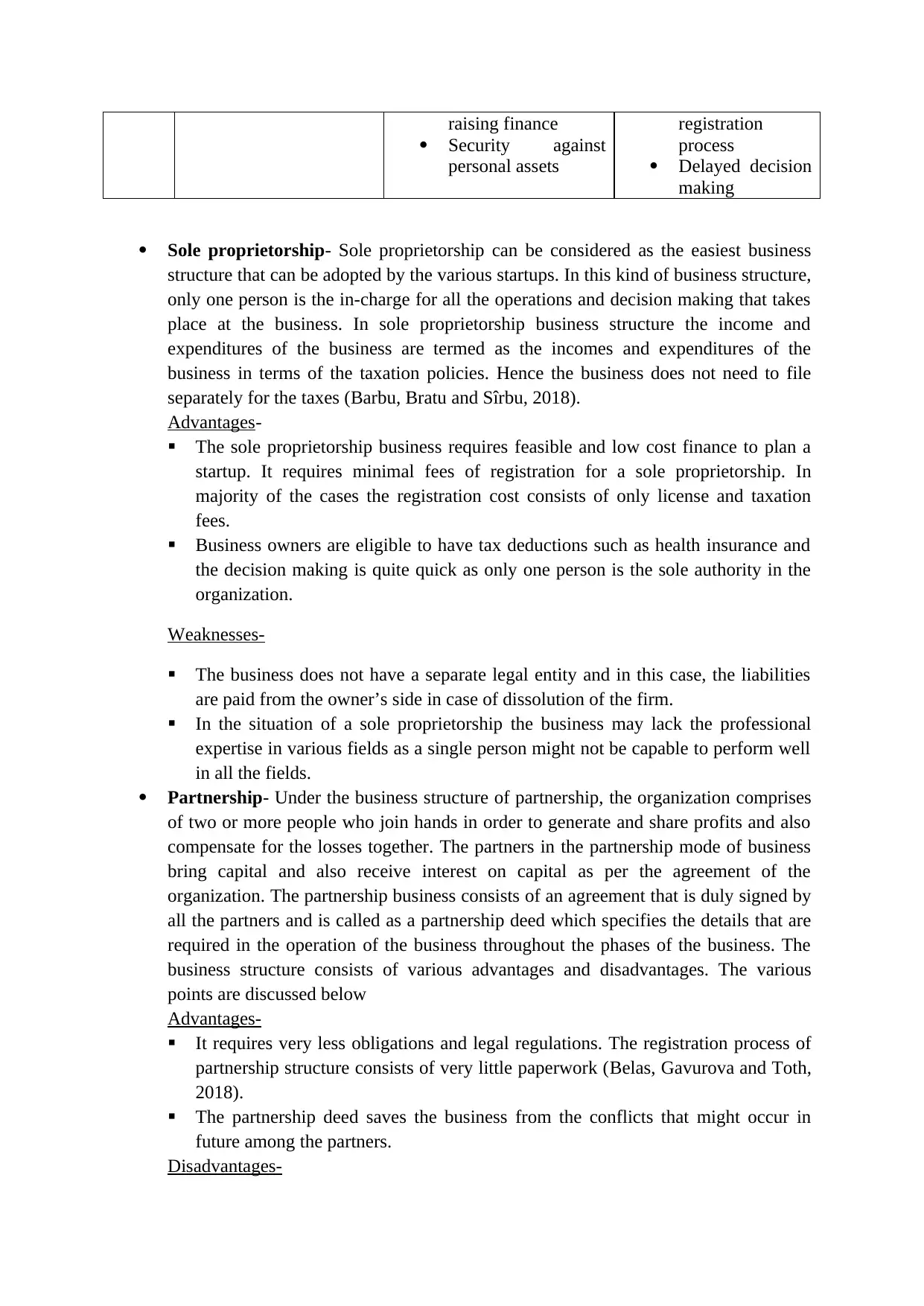
raising finance
Security against
personal assets
registration
process
Delayed decision
making
Sole proprietorship- Sole proprietorship can be considered as the easiest business
structure that can be adopted by the various startups. In this kind of business structure,
only one person is the in-charge for all the operations and decision making that takes
place at the business. In sole proprietorship business structure the income and
expenditures of the business are termed as the incomes and expenditures of the
business in terms of the taxation policies. Hence the business does not need to file
separately for the taxes (Barbu, Bratu and Sîrbu, 2018).
Advantages-
The sole proprietorship business requires feasible and low cost finance to plan a
startup. It requires minimal fees of registration for a sole proprietorship. In
majority of the cases the registration cost consists of only license and taxation
fees.
Business owners are eligible to have tax deductions such as health insurance and
the decision making is quite quick as only one person is the sole authority in the
organization.
Weaknesses-
The business does not have a separate legal entity and in this case, the liabilities
are paid from the owner’s side in case of dissolution of the firm.
In the situation of a sole proprietorship the business may lack the professional
expertise in various fields as a single person might not be capable to perform well
in all the fields.
Partnership- Under the business structure of partnership, the organization comprises
of two or more people who join hands in order to generate and share profits and also
compensate for the losses together. The partners in the partnership mode of business
bring capital and also receive interest on capital as per the agreement of the
organization. The partnership business consists of an agreement that is duly signed by
all the partners and is called as a partnership deed which specifies the details that are
required in the operation of the business throughout the phases of the business. The
business structure consists of various advantages and disadvantages. The various
points are discussed below
Advantages-
It requires very less obligations and legal regulations. The registration process of
partnership structure consists of very little paperwork (Belas, Gavurova and Toth,
2018).
The partnership deed saves the business from the conflicts that might occur in
future among the partners.
Disadvantages-
Security against
personal assets
registration
process
Delayed decision
making
Sole proprietorship- Sole proprietorship can be considered as the easiest business
structure that can be adopted by the various startups. In this kind of business structure,
only one person is the in-charge for all the operations and decision making that takes
place at the business. In sole proprietorship business structure the income and
expenditures of the business are termed as the incomes and expenditures of the
business in terms of the taxation policies. Hence the business does not need to file
separately for the taxes (Barbu, Bratu and Sîrbu, 2018).
Advantages-
The sole proprietorship business requires feasible and low cost finance to plan a
startup. It requires minimal fees of registration for a sole proprietorship. In
majority of the cases the registration cost consists of only license and taxation
fees.
Business owners are eligible to have tax deductions such as health insurance and
the decision making is quite quick as only one person is the sole authority in the
organization.
Weaknesses-
The business does not have a separate legal entity and in this case, the liabilities
are paid from the owner’s side in case of dissolution of the firm.
In the situation of a sole proprietorship the business may lack the professional
expertise in various fields as a single person might not be capable to perform well
in all the fields.
Partnership- Under the business structure of partnership, the organization comprises
of two or more people who join hands in order to generate and share profits and also
compensate for the losses together. The partners in the partnership mode of business
bring capital and also receive interest on capital as per the agreement of the
organization. The partnership business consists of an agreement that is duly signed by
all the partners and is called as a partnership deed which specifies the details that are
required in the operation of the business throughout the phases of the business. The
business structure consists of various advantages and disadvantages. The various
points are discussed below
Advantages-
It requires very less obligations and legal regulations. The registration process of
partnership structure consists of very little paperwork (Belas, Gavurova and Toth,
2018).
The partnership deed saves the business from the conflicts that might occur in
future among the partners.
Disadvantages-
Paraphrase This Document
Need a fresh take? Get an instant paraphrase of this document with our AI Paraphraser
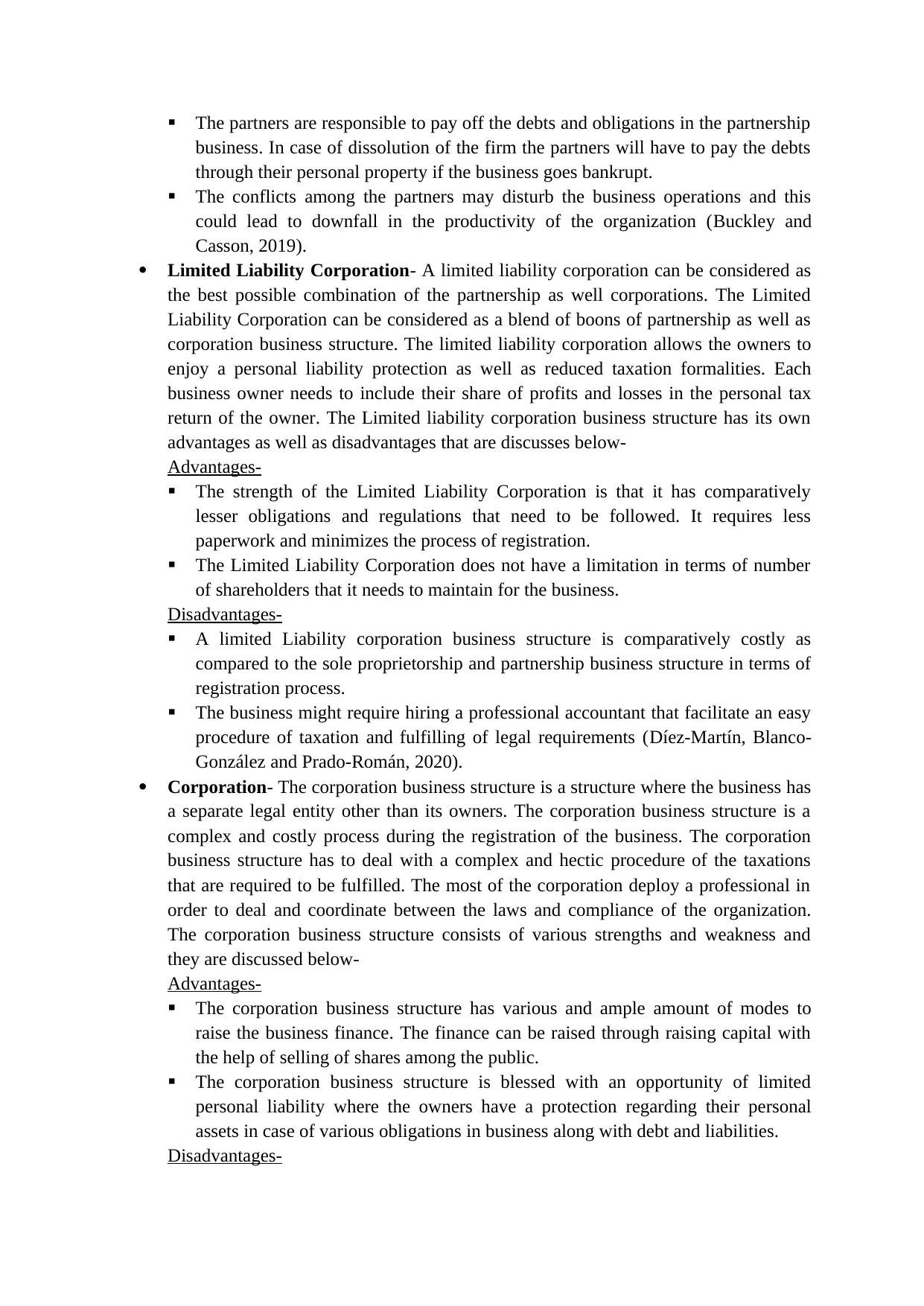
The partners are responsible to pay off the debts and obligations in the partnership
business. In case of dissolution of the firm the partners will have to pay the debts
through their personal property if the business goes bankrupt.
The conflicts among the partners may disturb the business operations and this
could lead to downfall in the productivity of the organization (Buckley and
Casson, 2019).
Limited Liability Corporation- A limited liability corporation can be considered as
the best possible combination of the partnership as well corporations. The Limited
Liability Corporation can be considered as a blend of boons of partnership as well as
corporation business structure. The limited liability corporation allows the owners to
enjoy a personal liability protection as well as reduced taxation formalities. Each
business owner needs to include their share of profits and losses in the personal tax
return of the owner. The Limited liability corporation business structure has its own
advantages as well as disadvantages that are discusses below-
Advantages-
The strength of the Limited Liability Corporation is that it has comparatively
lesser obligations and regulations that need to be followed. It requires less
paperwork and minimizes the process of registration.
The Limited Liability Corporation does not have a limitation in terms of number
of shareholders that it needs to maintain for the business.
Disadvantages-
A limited Liability corporation business structure is comparatively costly as
compared to the sole proprietorship and partnership business structure in terms of
registration process.
The business might require hiring a professional accountant that facilitate an easy
procedure of taxation and fulfilling of legal requirements (Díez-Martín, Blanco-
González and Prado-Román, 2020).
Corporation- The corporation business structure is a structure where the business has
a separate legal entity other than its owners. The corporation business structure is a
complex and costly process during the registration of the business. The corporation
business structure has to deal with a complex and hectic procedure of the taxations
that are required to be fulfilled. The most of the corporation deploy a professional in
order to deal and coordinate between the laws and compliance of the organization.
The corporation business structure consists of various strengths and weakness and
they are discussed below-
Advantages-
The corporation business structure has various and ample amount of modes to
raise the business finance. The finance can be raised through raising capital with
the help of selling of shares among the public.
The corporation business structure is blessed with an opportunity of limited
personal liability where the owners have a protection regarding their personal
assets in case of various obligations in business along with debt and liabilities.
Disadvantages-
business. In case of dissolution of the firm the partners will have to pay the debts
through their personal property if the business goes bankrupt.
The conflicts among the partners may disturb the business operations and this
could lead to downfall in the productivity of the organization (Buckley and
Casson, 2019).
Limited Liability Corporation- A limited liability corporation can be considered as
the best possible combination of the partnership as well corporations. The Limited
Liability Corporation can be considered as a blend of boons of partnership as well as
corporation business structure. The limited liability corporation allows the owners to
enjoy a personal liability protection as well as reduced taxation formalities. Each
business owner needs to include their share of profits and losses in the personal tax
return of the owner. The Limited liability corporation business structure has its own
advantages as well as disadvantages that are discusses below-
Advantages-
The strength of the Limited Liability Corporation is that it has comparatively
lesser obligations and regulations that need to be followed. It requires less
paperwork and minimizes the process of registration.
The Limited Liability Corporation does not have a limitation in terms of number
of shareholders that it needs to maintain for the business.
Disadvantages-
A limited Liability corporation business structure is comparatively costly as
compared to the sole proprietorship and partnership business structure in terms of
registration process.
The business might require hiring a professional accountant that facilitate an easy
procedure of taxation and fulfilling of legal requirements (Díez-Martín, Blanco-
González and Prado-Román, 2020).
Corporation- The corporation business structure is a structure where the business has
a separate legal entity other than its owners. The corporation business structure is a
complex and costly process during the registration of the business. The corporation
business structure has to deal with a complex and hectic procedure of the taxations
that are required to be fulfilled. The most of the corporation deploy a professional in
order to deal and coordinate between the laws and compliance of the organization.
The corporation business structure consists of various strengths and weakness and
they are discussed below-
Advantages-
The corporation business structure has various and ample amount of modes to
raise the business finance. The finance can be raised through raising capital with
the help of selling of shares among the public.
The corporation business structure is blessed with an opportunity of limited
personal liability where the owners have a protection regarding their personal
assets in case of various obligations in business along with debt and liabilities.
Disadvantages-
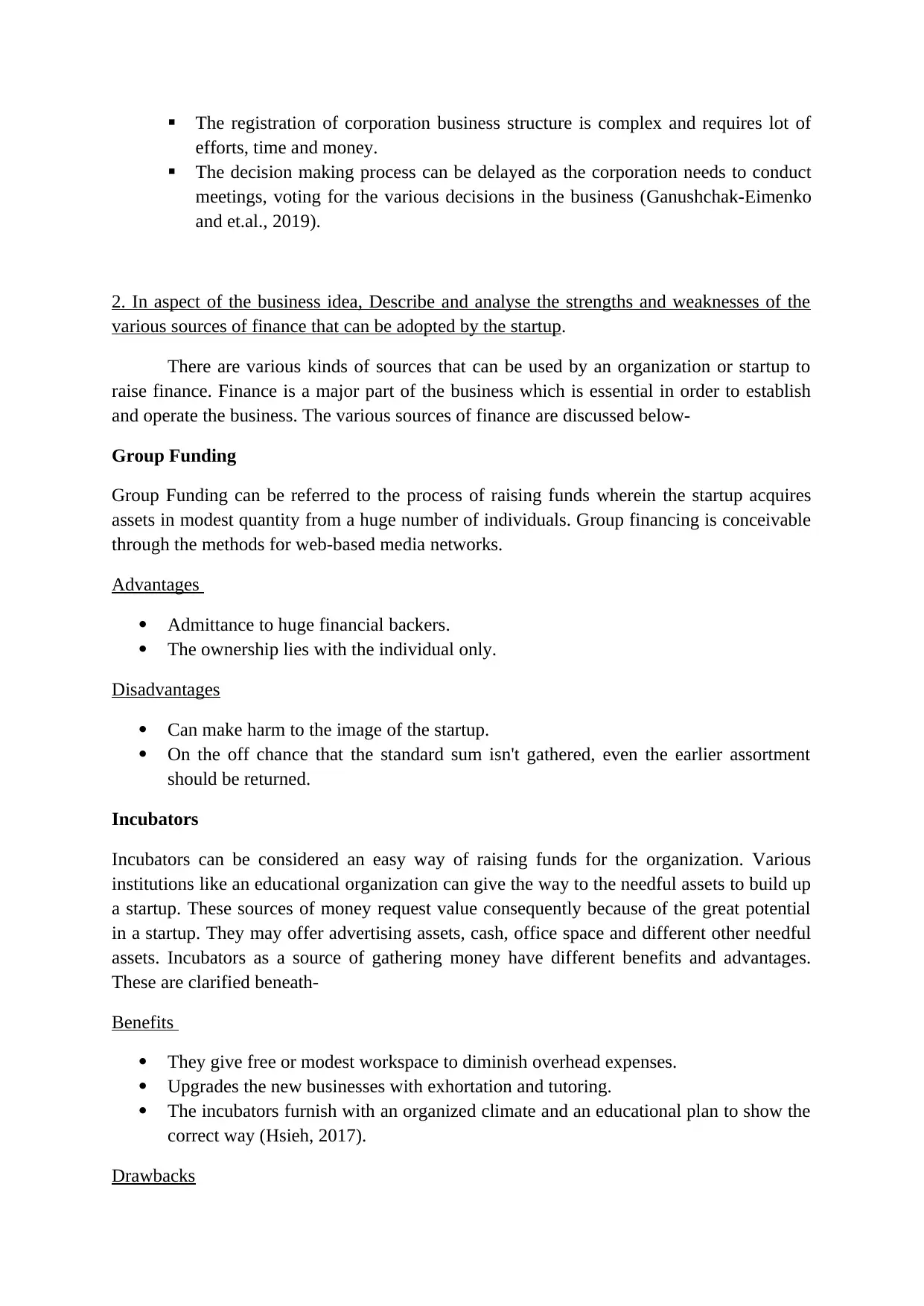
The registration of corporation business structure is complex and requires lot of
efforts, time and money.
The decision making process can be delayed as the corporation needs to conduct
meetings, voting for the various decisions in the business (Ganushchak-Eimenko
and et.al., 2019).
2. In aspect of the business idea, Describe and analyse the strengths and weaknesses of the
various sources of finance that can be adopted by the startup.
There are various kinds of sources that can be used by an organization or startup to
raise finance. Finance is a major part of the business which is essential in order to establish
and operate the business. The various sources of finance are discussed below-
Group Funding
Group Funding can be referred to the process of raising funds wherein the startup acquires
assets in modest quantity from a huge number of individuals. Group financing is conceivable
through the methods for web-based media networks.
Advantages
Admittance to huge financial backers.
The ownership lies with the individual only.
Disadvantages
Can make harm to the image of the startup.
On the off chance that the standard sum isn't gathered, even the earlier assortment
should be returned.
Incubators
Incubators can be considered an easy way of raising funds for the organization. Various
institutions like an educational organization can give the way to the needful assets to build up
a startup. These sources of money request value consequently because of the great potential
in a startup. They may offer advertising assets, cash, office space and different other needful
assets. Incubators as a source of gathering money have different benefits and advantages.
These are clarified beneath-
Benefits
They give free or modest workspace to diminish overhead expenses.
Upgrades the new businesses with exhortation and tutoring.
The incubators furnish with an organized climate and an educational plan to show the
correct way (Hsieh, 2017).
Drawbacks
efforts, time and money.
The decision making process can be delayed as the corporation needs to conduct
meetings, voting for the various decisions in the business (Ganushchak-Eimenko
and et.al., 2019).
2. In aspect of the business idea, Describe and analyse the strengths and weaknesses of the
various sources of finance that can be adopted by the startup.
There are various kinds of sources that can be used by an organization or startup to
raise finance. Finance is a major part of the business which is essential in order to establish
and operate the business. The various sources of finance are discussed below-
Group Funding
Group Funding can be referred to the process of raising funds wherein the startup acquires
assets in modest quantity from a huge number of individuals. Group financing is conceivable
through the methods for web-based media networks.
Advantages
Admittance to huge financial backers.
The ownership lies with the individual only.
Disadvantages
Can make harm to the image of the startup.
On the off chance that the standard sum isn't gathered, even the earlier assortment
should be returned.
Incubators
Incubators can be considered an easy way of raising funds for the organization. Various
institutions like an educational organization can give the way to the needful assets to build up
a startup. These sources of money request value consequently because of the great potential
in a startup. They may offer advertising assets, cash, office space and different other needful
assets. Incubators as a source of gathering money have different benefits and advantages.
These are clarified beneath-
Benefits
They give free or modest workspace to diminish overhead expenses.
Upgrades the new businesses with exhortation and tutoring.
The incubators furnish with an organized climate and an educational plan to show the
correct way (Hsieh, 2017).
Drawbacks
⊘ This is a preview!⊘
Do you want full access?
Subscribe today to unlock all pages.

Trusted by 1+ million students worldwide
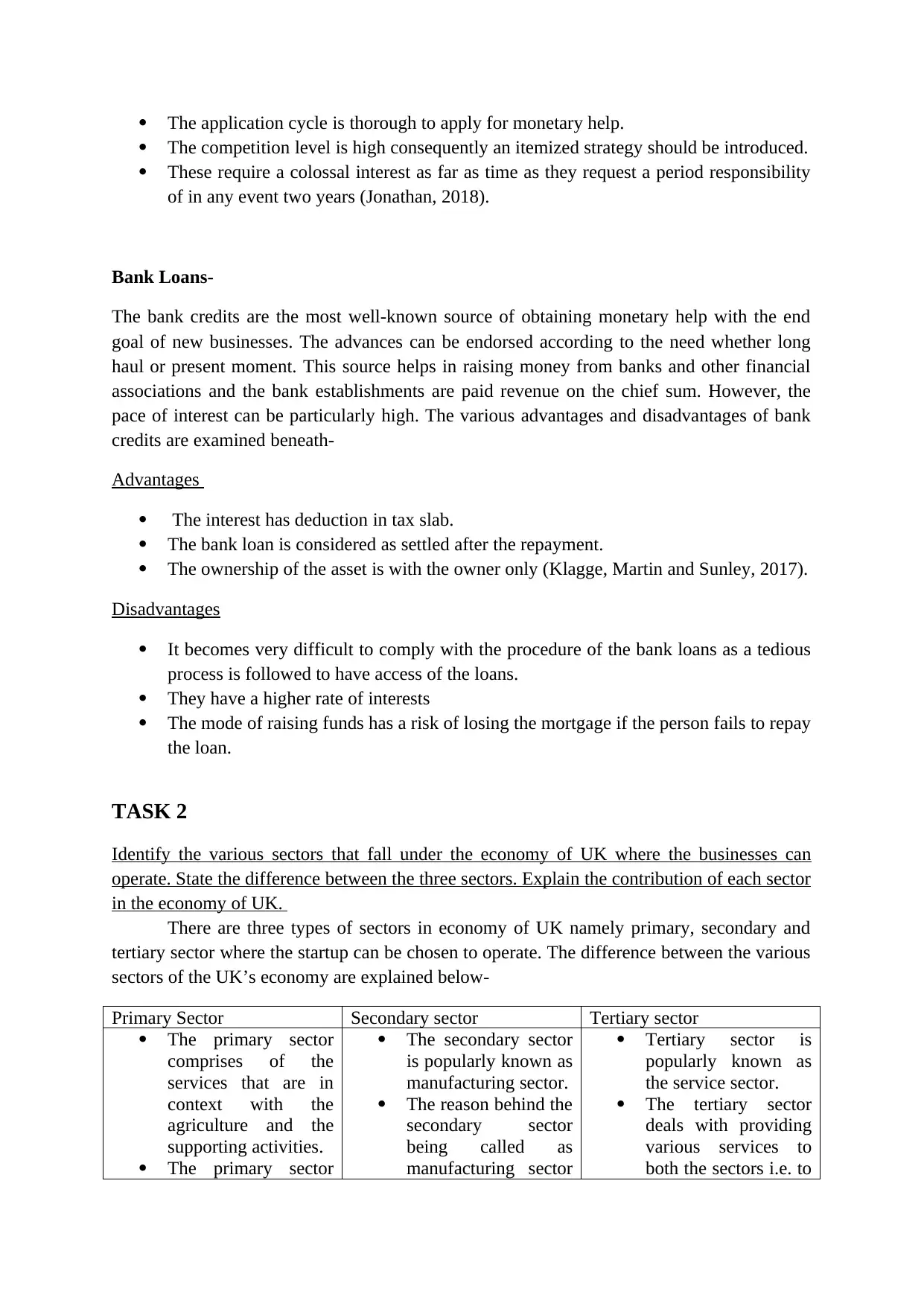
The application cycle is thorough to apply for monetary help.
The competition level is high consequently an itemized strategy should be introduced.
These require a colossal interest as far as time as they request a period responsibility
of in any event two years (Jonathan, 2018).
Bank Loans-
The bank credits are the most well-known source of obtaining monetary help with the end
goal of new businesses. The advances can be endorsed according to the need whether long
haul or present moment. This source helps in raising money from banks and other financial
associations and the bank establishments are paid revenue on the chief sum. However, the
pace of interest can be particularly high. The various advantages and disadvantages of bank
credits are examined beneath-
Advantages
The interest has deduction in tax slab.
The bank loan is considered as settled after the repayment.
The ownership of the asset is with the owner only (Klagge, Martin and Sunley, 2017).
Disadvantages
It becomes very difficult to comply with the procedure of the bank loans as a tedious
process is followed to have access of the loans.
They have a higher rate of interests
The mode of raising funds has a risk of losing the mortgage if the person fails to repay
the loan.
TASK 2
Identify the various sectors that fall under the economy of UK where the businesses can
operate. State the difference between the three sectors. Explain the contribution of each sector
in the economy of UK.
There are three types of sectors in economy of UK namely primary, secondary and
tertiary sector where the startup can be chosen to operate. The difference between the various
sectors of the UK’s economy are explained below-
Primary Sector Secondary sector Tertiary sector
The primary sector
comprises of the
services that are in
context with the
agriculture and the
supporting activities.
The primary sector
The secondary sector
is popularly known as
manufacturing sector.
The reason behind the
secondary sector
being called as
manufacturing sector
Tertiary sector is
popularly known as
the service sector.
The tertiary sector
deals with providing
various services to
both the sectors i.e. to
The competition level is high consequently an itemized strategy should be introduced.
These require a colossal interest as far as time as they request a period responsibility
of in any event two years (Jonathan, 2018).
Bank Loans-
The bank credits are the most well-known source of obtaining monetary help with the end
goal of new businesses. The advances can be endorsed according to the need whether long
haul or present moment. This source helps in raising money from banks and other financial
associations and the bank establishments are paid revenue on the chief sum. However, the
pace of interest can be particularly high. The various advantages and disadvantages of bank
credits are examined beneath-
Advantages
The interest has deduction in tax slab.
The bank loan is considered as settled after the repayment.
The ownership of the asset is with the owner only (Klagge, Martin and Sunley, 2017).
Disadvantages
It becomes very difficult to comply with the procedure of the bank loans as a tedious
process is followed to have access of the loans.
They have a higher rate of interests
The mode of raising funds has a risk of losing the mortgage if the person fails to repay
the loan.
TASK 2
Identify the various sectors that fall under the economy of UK where the businesses can
operate. State the difference between the three sectors. Explain the contribution of each sector
in the economy of UK.
There are three types of sectors in economy of UK namely primary, secondary and
tertiary sector where the startup can be chosen to operate. The difference between the various
sectors of the UK’s economy are explained below-
Primary Sector Secondary sector Tertiary sector
The primary sector
comprises of the
services that are in
context with the
agriculture and the
supporting activities.
The primary sector
The secondary sector
is popularly known as
manufacturing sector.
The reason behind the
secondary sector
being called as
manufacturing sector
Tertiary sector is
popularly known as
the service sector.
The tertiary sector
deals with providing
various services to
both the sectors i.e. to
Paraphrase This Document
Need a fresh take? Get an instant paraphrase of this document with our AI Paraphraser
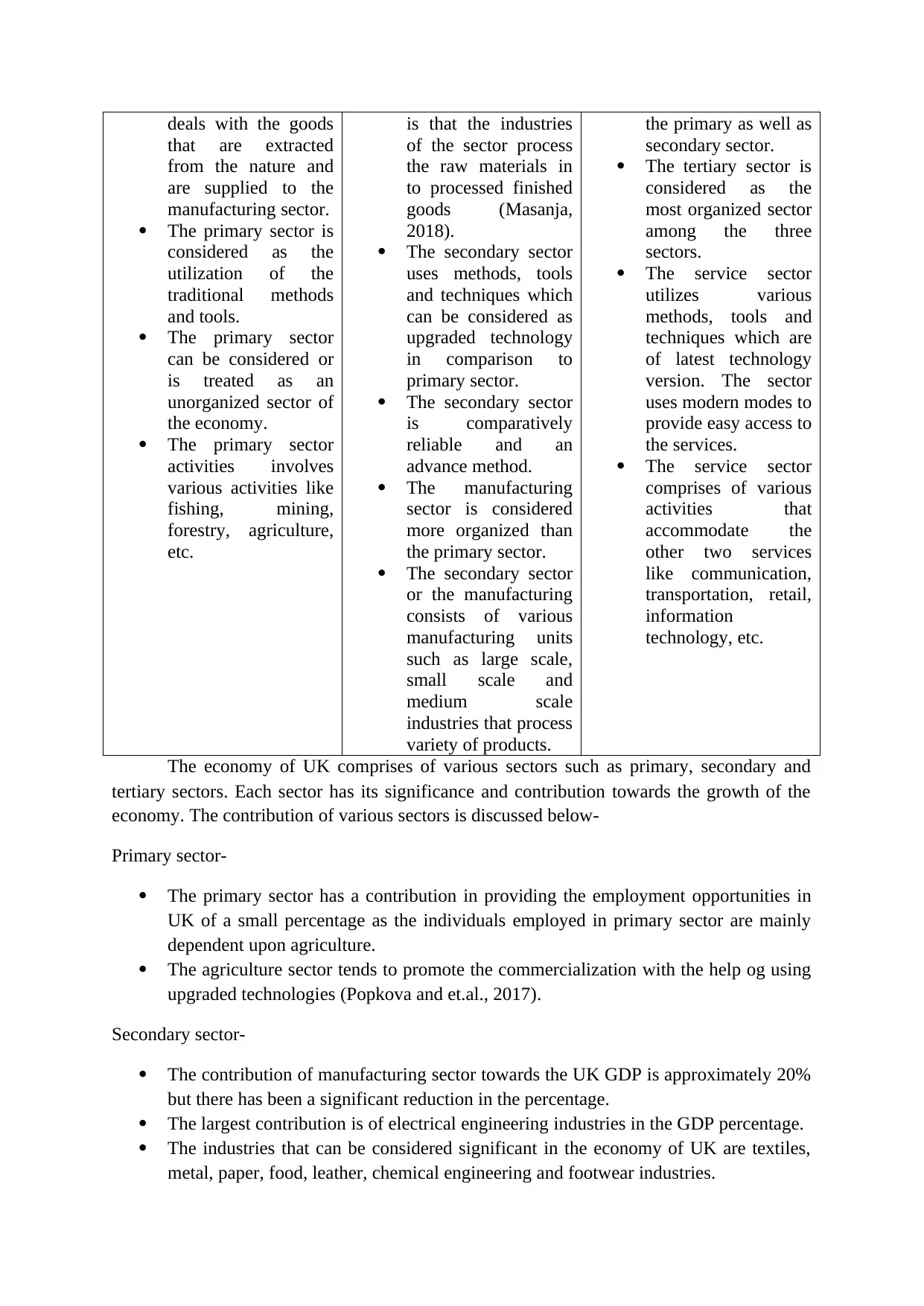
deals with the goods
that are extracted
from the nature and
are supplied to the
manufacturing sector.
The primary sector is
considered as the
utilization of the
traditional methods
and tools.
The primary sector
can be considered or
is treated as an
unorganized sector of
the economy.
The primary sector
activities involves
various activities like
fishing, mining,
forestry, agriculture,
etc.
is that the industries
of the sector process
the raw materials in
to processed finished
goods (Masanja,
2018).
The secondary sector
uses methods, tools
and techniques which
can be considered as
upgraded technology
in comparison to
primary sector.
The secondary sector
is comparatively
reliable and an
advance method.
The manufacturing
sector is considered
more organized than
the primary sector.
The secondary sector
or the manufacturing
consists of various
manufacturing units
such as large scale,
small scale and
medium scale
industries that process
variety of products.
the primary as well as
secondary sector.
The tertiary sector is
considered as the
most organized sector
among the three
sectors.
The service sector
utilizes various
methods, tools and
techniques which are
of latest technology
version. The sector
uses modern modes to
provide easy access to
the services.
The service sector
comprises of various
activities that
accommodate the
other two services
like communication,
transportation, retail,
information
technology, etc.
The economy of UK comprises of various sectors such as primary, secondary and
tertiary sectors. Each sector has its significance and contribution towards the growth of the
economy. The contribution of various sectors is discussed below-
Primary sector-
The primary sector has a contribution in providing the employment opportunities in
UK of a small percentage as the individuals employed in primary sector are mainly
dependent upon agriculture.
The agriculture sector tends to promote the commercialization with the help og using
upgraded technologies (Popkova and et.al., 2017).
Secondary sector-
The contribution of manufacturing sector towards the UK GDP is approximately 20%
but there has been a significant reduction in the percentage.
The largest contribution is of electrical engineering industries in the GDP percentage.
The industries that can be considered significant in the economy of UK are textiles,
metal, paper, food, leather, chemical engineering and footwear industries.
that are extracted
from the nature and
are supplied to the
manufacturing sector.
The primary sector is
considered as the
utilization of the
traditional methods
and tools.
The primary sector
can be considered or
is treated as an
unorganized sector of
the economy.
The primary sector
activities involves
various activities like
fishing, mining,
forestry, agriculture,
etc.
is that the industries
of the sector process
the raw materials in
to processed finished
goods (Masanja,
2018).
The secondary sector
uses methods, tools
and techniques which
can be considered as
upgraded technology
in comparison to
primary sector.
The secondary sector
is comparatively
reliable and an
advance method.
The manufacturing
sector is considered
more organized than
the primary sector.
The secondary sector
or the manufacturing
consists of various
manufacturing units
such as large scale,
small scale and
medium scale
industries that process
variety of products.
the primary as well as
secondary sector.
The tertiary sector is
considered as the
most organized sector
among the three
sectors.
The service sector
utilizes various
methods, tools and
techniques which are
of latest technology
version. The sector
uses modern modes to
provide easy access to
the services.
The service sector
comprises of various
activities that
accommodate the
other two services
like communication,
transportation, retail,
information
technology, etc.
The economy of UK comprises of various sectors such as primary, secondary and
tertiary sectors. Each sector has its significance and contribution towards the growth of the
economy. The contribution of various sectors is discussed below-
Primary sector-
The primary sector has a contribution in providing the employment opportunities in
UK of a small percentage as the individuals employed in primary sector are mainly
dependent upon agriculture.
The agriculture sector tends to promote the commercialization with the help og using
upgraded technologies (Popkova and et.al., 2017).
Secondary sector-
The contribution of manufacturing sector towards the UK GDP is approximately 20%
but there has been a significant reduction in the percentage.
The largest contribution is of electrical engineering industries in the GDP percentage.
The industries that can be considered significant in the economy of UK are textiles,
metal, paper, food, leather, chemical engineering and footwear industries.
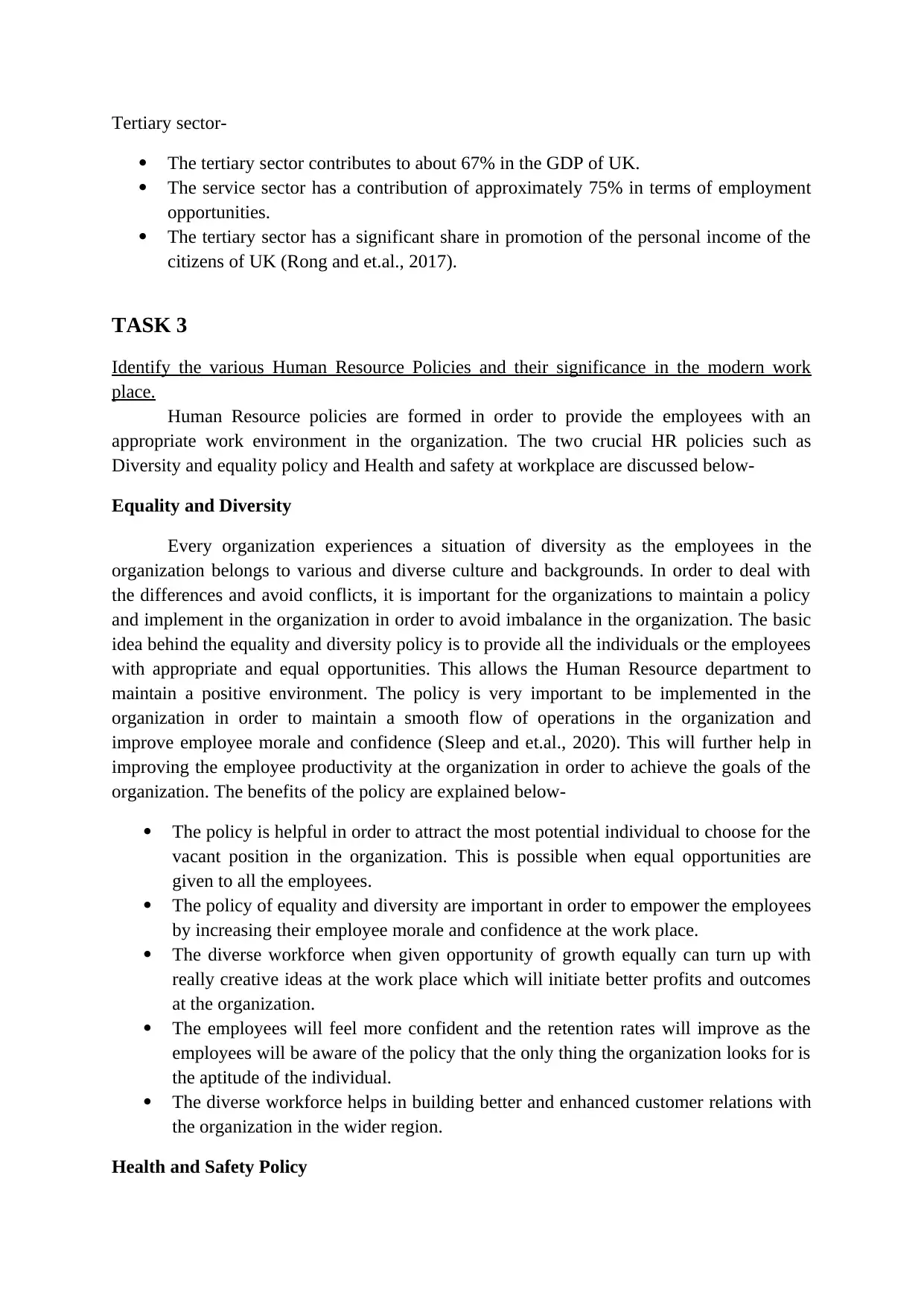
Tertiary sector-
The tertiary sector contributes to about 67% in the GDP of UK.
The service sector has a contribution of approximately 75% in terms of employment
opportunities.
The tertiary sector has a significant share in promotion of the personal income of the
citizens of UK (Rong and et.al., 2017).
TASK 3
Identify the various Human Resource Policies and their significance in the modern work
place.
Human Resource policies are formed in order to provide the employees with an
appropriate work environment in the organization. The two crucial HR policies such as
Diversity and equality policy and Health and safety at workplace are discussed below-
Equality and Diversity
Every organization experiences a situation of diversity as the employees in the
organization belongs to various and diverse culture and backgrounds. In order to deal with
the differences and avoid conflicts, it is important for the organizations to maintain a policy
and implement in the organization in order to avoid imbalance in the organization. The basic
idea behind the equality and diversity policy is to provide all the individuals or the employees
with appropriate and equal opportunities. This allows the Human Resource department to
maintain a positive environment. The policy is very important to be implemented in the
organization in order to maintain a smooth flow of operations in the organization and
improve employee morale and confidence (Sleep and et.al., 2020). This will further help in
improving the employee productivity at the organization in order to achieve the goals of the
organization. The benefits of the policy are explained below-
The policy is helpful in order to attract the most potential individual to choose for the
vacant position in the organization. This is possible when equal opportunities are
given to all the employees.
The policy of equality and diversity are important in order to empower the employees
by increasing their employee morale and confidence at the work place.
The diverse workforce when given opportunity of growth equally can turn up with
really creative ideas at the work place which will initiate better profits and outcomes
at the organization.
The employees will feel more confident and the retention rates will improve as the
employees will be aware of the policy that the only thing the organization looks for is
the aptitude of the individual.
The diverse workforce helps in building better and enhanced customer relations with
the organization in the wider region.
Health and Safety Policy
The tertiary sector contributes to about 67% in the GDP of UK.
The service sector has a contribution of approximately 75% in terms of employment
opportunities.
The tertiary sector has a significant share in promotion of the personal income of the
citizens of UK (Rong and et.al., 2017).
TASK 3
Identify the various Human Resource Policies and their significance in the modern work
place.
Human Resource policies are formed in order to provide the employees with an
appropriate work environment in the organization. The two crucial HR policies such as
Diversity and equality policy and Health and safety at workplace are discussed below-
Equality and Diversity
Every organization experiences a situation of diversity as the employees in the
organization belongs to various and diverse culture and backgrounds. In order to deal with
the differences and avoid conflicts, it is important for the organizations to maintain a policy
and implement in the organization in order to avoid imbalance in the organization. The basic
idea behind the equality and diversity policy is to provide all the individuals or the employees
with appropriate and equal opportunities. This allows the Human Resource department to
maintain a positive environment. The policy is very important to be implemented in the
organization in order to maintain a smooth flow of operations in the organization and
improve employee morale and confidence (Sleep and et.al., 2020). This will further help in
improving the employee productivity at the organization in order to achieve the goals of the
organization. The benefits of the policy are explained below-
The policy is helpful in order to attract the most potential individual to choose for the
vacant position in the organization. This is possible when equal opportunities are
given to all the employees.
The policy of equality and diversity are important in order to empower the employees
by increasing their employee morale and confidence at the work place.
The diverse workforce when given opportunity of growth equally can turn up with
really creative ideas at the work place which will initiate better profits and outcomes
at the organization.
The employees will feel more confident and the retention rates will improve as the
employees will be aware of the policy that the only thing the organization looks for is
the aptitude of the individual.
The diverse workforce helps in building better and enhanced customer relations with
the organization in the wider region.
Health and Safety Policy
⊘ This is a preview!⊘
Do you want full access?
Subscribe today to unlock all pages.

Trusted by 1+ million students worldwide
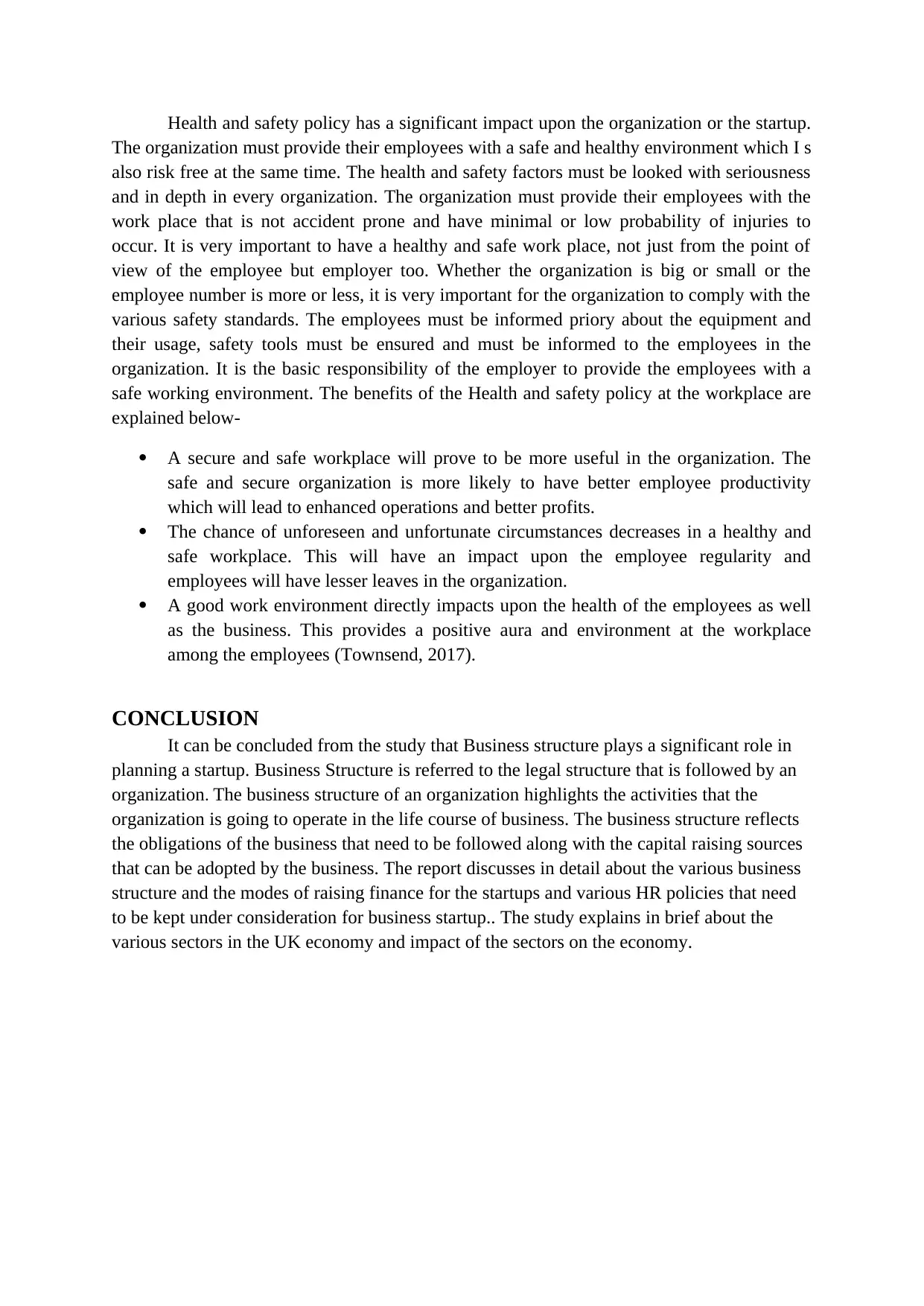
Health and safety policy has a significant impact upon the organization or the startup.
The organization must provide their employees with a safe and healthy environment which I s
also risk free at the same time. The health and safety factors must be looked with seriousness
and in depth in every organization. The organization must provide their employees with the
work place that is not accident prone and have minimal or low probability of injuries to
occur. It is very important to have a healthy and safe work place, not just from the point of
view of the employee but employer too. Whether the organization is big or small or the
employee number is more or less, it is very important for the organization to comply with the
various safety standards. The employees must be informed priory about the equipment and
their usage, safety tools must be ensured and must be informed to the employees in the
organization. It is the basic responsibility of the employer to provide the employees with a
safe working environment. The benefits of the Health and safety policy at the workplace are
explained below-
A secure and safe workplace will prove to be more useful in the organization. The
safe and secure organization is more likely to have better employee productivity
which will lead to enhanced operations and better profits.
The chance of unforeseen and unfortunate circumstances decreases in a healthy and
safe workplace. This will have an impact upon the employee regularity and
employees will have lesser leaves in the organization.
A good work environment directly impacts upon the health of the employees as well
as the business. This provides a positive aura and environment at the workplace
among the employees (Townsend, 2017).
CONCLUSION
It can be concluded from the study that Business structure plays a significant role in
planning a startup. Business Structure is referred to the legal structure that is followed by an
organization. The business structure of an organization highlights the activities that the
organization is going to operate in the life course of business. The business structure reflects
the obligations of the business that need to be followed along with the capital raising sources
that can be adopted by the business. The report discusses in detail about the various business
structure and the modes of raising finance for the startups and various HR policies that need
to be kept under consideration for business startup.. The study explains in brief about the
various sectors in the UK economy and impact of the sectors on the economy.
The organization must provide their employees with a safe and healthy environment which I s
also risk free at the same time. The health and safety factors must be looked with seriousness
and in depth in every organization. The organization must provide their employees with the
work place that is not accident prone and have minimal or low probability of injuries to
occur. It is very important to have a healthy and safe work place, not just from the point of
view of the employee but employer too. Whether the organization is big or small or the
employee number is more or less, it is very important for the organization to comply with the
various safety standards. The employees must be informed priory about the equipment and
their usage, safety tools must be ensured and must be informed to the employees in the
organization. It is the basic responsibility of the employer to provide the employees with a
safe working environment. The benefits of the Health and safety policy at the workplace are
explained below-
A secure and safe workplace will prove to be more useful in the organization. The
safe and secure organization is more likely to have better employee productivity
which will lead to enhanced operations and better profits.
The chance of unforeseen and unfortunate circumstances decreases in a healthy and
safe workplace. This will have an impact upon the employee regularity and
employees will have lesser leaves in the organization.
A good work environment directly impacts upon the health of the employees as well
as the business. This provides a positive aura and environment at the workplace
among the employees (Townsend, 2017).
CONCLUSION
It can be concluded from the study that Business structure plays a significant role in
planning a startup. Business Structure is referred to the legal structure that is followed by an
organization. The business structure of an organization highlights the activities that the
organization is going to operate in the life course of business. The business structure reflects
the obligations of the business that need to be followed along with the capital raising sources
that can be adopted by the business. The report discusses in detail about the various business
structure and the modes of raising finance for the startups and various HR policies that need
to be kept under consideration for business startup.. The study explains in brief about the
various sectors in the UK economy and impact of the sectors on the economy.
Paraphrase This Document
Need a fresh take? Get an instant paraphrase of this document with our AI Paraphraser
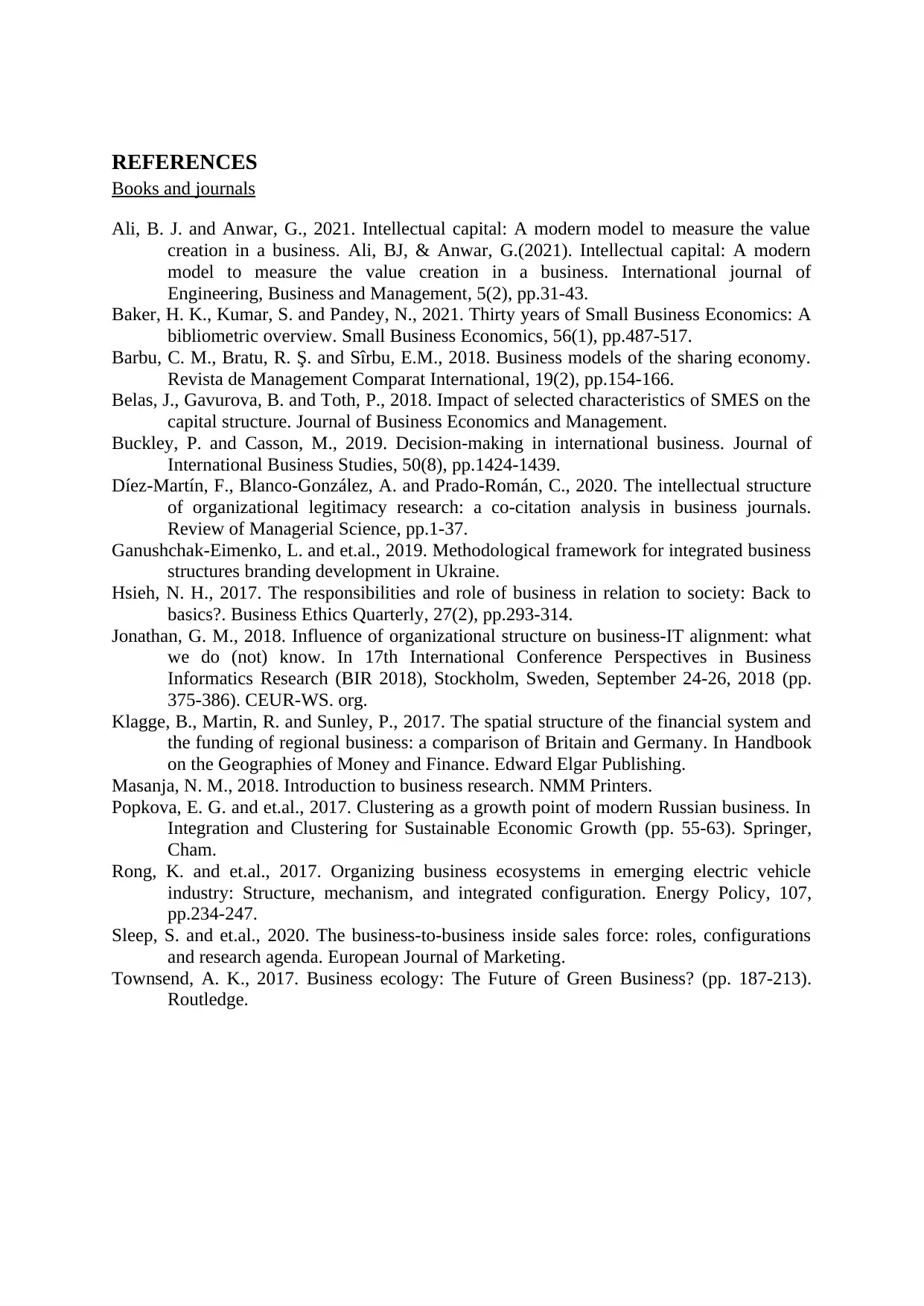
REFERENCES
Books and journals
Ali, B. J. and Anwar, G., 2021. Intellectual capital: A modern model to measure the value
creation in a business. Ali, BJ, & Anwar, G.(2021). Intellectual capital: A modern
model to measure the value creation in a business. International journal of
Engineering, Business and Management, 5(2), pp.31-43.
Baker, H. K., Kumar, S. and Pandey, N., 2021. Thirty years of Small Business Economics: A
bibliometric overview. Small Business Economics, 56(1), pp.487-517.
Barbu, C. M., Bratu, R. Ş. and Sîrbu, E.M., 2018. Business models of the sharing economy.
Revista de Management Comparat International, 19(2), pp.154-166.
Belas, J., Gavurova, B. and Toth, P., 2018. Impact of selected characteristics of SMES on the
capital structure. Journal of Business Economics and Management.
Buckley, P. and Casson, M., 2019. Decision-making in international business. Journal of
International Business Studies, 50(8), pp.1424-1439.
Díez-Martín, F., Blanco-González, A. and Prado-Román, C., 2020. The intellectual structure
of organizational legitimacy research: a co-citation analysis in business journals.
Review of Managerial Science, pp.1-37.
Ganushchak-Eimenko, L. and et.al., 2019. Methodological framework for integrated business
structures branding development in Ukraine.
Hsieh, N. H., 2017. The responsibilities and role of business in relation to society: Back to
basics?. Business Ethics Quarterly, 27(2), pp.293-314.
Jonathan, G. M., 2018. Influence of organizational structure on business-IT alignment: what
we do (not) know. In 17th International Conference Perspectives in Business
Informatics Research (BIR 2018), Stockholm, Sweden, September 24-26, 2018 (pp.
375-386). CEUR-WS. org.
Klagge, B., Martin, R. and Sunley, P., 2017. The spatial structure of the financial system and
the funding of regional business: a comparison of Britain and Germany. In Handbook
on the Geographies of Money and Finance. Edward Elgar Publishing.
Masanja, N. M., 2018. Introduction to business research. NMM Printers.
Popkova, E. G. and et.al., 2017. Clustering as a growth point of modern Russian business. In
Integration and Clustering for Sustainable Economic Growth (pp. 55-63). Springer,
Cham.
Rong, K. and et.al., 2017. Organizing business ecosystems in emerging electric vehicle
industry: Structure, mechanism, and integrated configuration. Energy Policy, 107,
pp.234-247.
Sleep, S. and et.al., 2020. The business-to-business inside sales force: roles, configurations
and research agenda. European Journal of Marketing.
Townsend, A. K., 2017. Business ecology: The Future of Green Business? (pp. 187-213).
Routledge.
Books and journals
Ali, B. J. and Anwar, G., 2021. Intellectual capital: A modern model to measure the value
creation in a business. Ali, BJ, & Anwar, G.(2021). Intellectual capital: A modern
model to measure the value creation in a business. International journal of
Engineering, Business and Management, 5(2), pp.31-43.
Baker, H. K., Kumar, S. and Pandey, N., 2021. Thirty years of Small Business Economics: A
bibliometric overview. Small Business Economics, 56(1), pp.487-517.
Barbu, C. M., Bratu, R. Ş. and Sîrbu, E.M., 2018. Business models of the sharing economy.
Revista de Management Comparat International, 19(2), pp.154-166.
Belas, J., Gavurova, B. and Toth, P., 2018. Impact of selected characteristics of SMES on the
capital structure. Journal of Business Economics and Management.
Buckley, P. and Casson, M., 2019. Decision-making in international business. Journal of
International Business Studies, 50(8), pp.1424-1439.
Díez-Martín, F., Blanco-González, A. and Prado-Román, C., 2020. The intellectual structure
of organizational legitimacy research: a co-citation analysis in business journals.
Review of Managerial Science, pp.1-37.
Ganushchak-Eimenko, L. and et.al., 2019. Methodological framework for integrated business
structures branding development in Ukraine.
Hsieh, N. H., 2017. The responsibilities and role of business in relation to society: Back to
basics?. Business Ethics Quarterly, 27(2), pp.293-314.
Jonathan, G. M., 2018. Influence of organizational structure on business-IT alignment: what
we do (not) know. In 17th International Conference Perspectives in Business
Informatics Research (BIR 2018), Stockholm, Sweden, September 24-26, 2018 (pp.
375-386). CEUR-WS. org.
Klagge, B., Martin, R. and Sunley, P., 2017. The spatial structure of the financial system and
the funding of regional business: a comparison of Britain and Germany. In Handbook
on the Geographies of Money and Finance. Edward Elgar Publishing.
Masanja, N. M., 2018. Introduction to business research. NMM Printers.
Popkova, E. G. and et.al., 2017. Clustering as a growth point of modern Russian business. In
Integration and Clustering for Sustainable Economic Growth (pp. 55-63). Springer,
Cham.
Rong, K. and et.al., 2017. Organizing business ecosystems in emerging electric vehicle
industry: Structure, mechanism, and integrated configuration. Energy Policy, 107,
pp.234-247.
Sleep, S. and et.al., 2020. The business-to-business inside sales force: roles, configurations
and research agenda. European Journal of Marketing.
Townsend, A. K., 2017. Business ecology: The Future of Green Business? (pp. 187-213).
Routledge.
1 out of 11
Related Documents
Your All-in-One AI-Powered Toolkit for Academic Success.
+13062052269
info@desklib.com
Available 24*7 on WhatsApp / Email
![[object Object]](/_next/static/media/star-bottom.7253800d.svg)
Unlock your academic potential
Copyright © 2020–2025 A2Z Services. All Rights Reserved. Developed and managed by ZUCOL.





